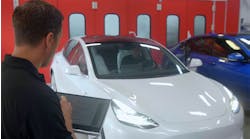At first glance, when we look at overall cycle time or key-to-key times, saving 10 minutes here, or 20 minutes there in a repair that takes (say) 10 days to complete, would not seem to be of any great significance. And you’re right; to some extent it’s not. But if a few minutes can be saved in the bottleneck (or constraint) of your business it will make a massive difference.
Let’s wind back a few steps and try, in summary, to understand this concept of constraints.
Work flows through your shop at different rates as you know, and at some points the flow is very rapid. At others, it is very slow. Similar to an old-fashioned egg timer or hourglass, the sand in it represents workflow, and at one point it queues to get through a narrow hole before it continues its journey to the bottom of the egg timer. What you notice is that the sand doesn’t flow any faster once through the narrowest part. This simulates what happens in business—flow, or output (invoicing) is determined by the slowest part of the operation (the sand landing on the bottom is at the rate the narrowest part allows).
This is an important concept to get your head around, because in other parts of the business there is obviously more flow, which seemingly is adding to output, but strangely, actually costs you a fortune. Overproducing in the wrong areas actually creates too much work-in-process (WIP), which in turn adds massive cost to your business. It creates queues, adds to cycle time, incurs massive cost, increases failure demand, chaos, customer communication, and so much more.
When we study the Theory of Constraints, we can break it down into five simple steps:
1 Identify your constraint. If your primary constraint (at any particular time) determines output, then how are you going to do anything about it if you don’t know where it is?
2 Exploit the constraint. If it determines output, then surely it makes complete sense to make sure it is fully utilized and running in its most efficient way.
3 Subordinate all other operations within the business to the constraint. We need to do this because if it starves, we stop output completely. Not only that, but that output can never be regained, because it’s the slowest part of your business. This means you need a mechanism to be able to always feed the constraint, that’s why we subordinate the rest of the business to it.
4 Elevate the constraint. In other words, make sure that once you have it working to its full potential, and it’s still your constraint, then you need to increase its capacity in order for it not to be your primary constraint, so in the case where it might be a spray booth, then it’s probably time to add another one.
5 Identify the constraint again, through the above four steps. If you have successfully eliminated the constraint, it will have moved elsewhere, which means you have to go right back to step one in order to reassess the situation to achieve improvement.
You can see from these simple steps (called the five focusing steps of the Theory of Constraint) that because the bottleneck in your business determines output, it has to be working flat-out all of the time. In many body shops, the paint booths can be the primary constraint, and therefore the time it takes to dry cars becomes very important. Fifteen minutes of savings in the whole spray cycle process can add up to a 20 percent throughput increase for the whole business. That’s one of the reasons in our shop that we use the radical Symach Drytronic robotic drying technology that will dry refinish paint in 53 seconds.
But don’t think of saving time drying as just increasing output through a constraint—consider how you might utilize productive staff in a different way. Imagine, for instance, that you could dry filler in just one minute—you wouldn’t have to have two or more cars on the go while filler is drying, so less WIP, shorter cycle times, etc. How about if you could roller prime and dry perfectly any repair in the bay that the vehicle sits in, within one minute? You wouldn’t have production stop-starts, you would reduce cycle time, you could focus technicians on one job, and you wouldn’t have to move the vehicle to your potential primary constraint (freeing up about 40 percent of its capacity). That means fewer masking products, less paint material… I could go on.
Eliminating drying time, in a Theory of Constraints environment, is an important factor. That’s why when we look at a systemic solution for body repair, drying time is critical. But only when it is part of a holistic solution.
Jon Parker is managing director of the Byteback Group, a U.K.-based information technology and services company aimed at advancing the collision repair industry.



